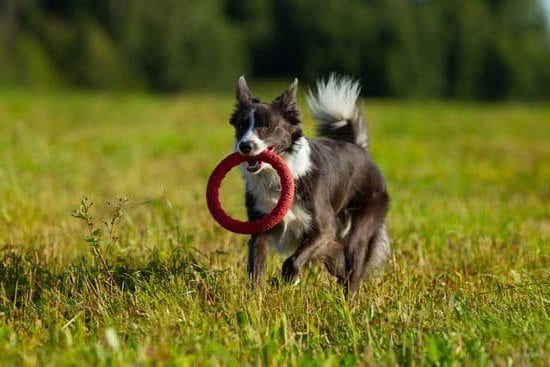Are you wondering, “how do you puppy pad train a dog“? Puppy pad training is an essential step in raising a well-behaved and house-trained dog.
Not only does it benefit the owner by reducing indoor accidents, but it also provides a convenient and safe way for dogs to relieve themselves when outdoor options are limited. In this article, we will delve into the basics of puppy pad training, from understanding what it is to choosing the right puppy pad and setting up a designated potty area for your furry friend.
Puppy pad training is a practical solution for both puppies and adult dogs, especially for those who live in apartments or areas with limited outdoor space. By teaching your dog to use a designated place indoors for potty breaks, you can avoid messes around the house and provide them with a consistent and reliable bathroom option. This method not only benefits the owner by maintaining cleanliness but also contributes to the dog’s overall wellbeing by establishing good potty habits.
In this comprehensive guide, we will walk you through everything you need to know about puppy pad training. From understanding the basics of this type of training to choosing the right puppy pads and creating a designated potty area, we’ve got you covered.
Additionally, we will provide tips on how to introduce your dog to the puppy pad, emphasize the importance of consistency in training, address accidents that may occur during the process, and offer guidance on transitioning from puppy pads to outdoor potty. So let’s get started on creating a happy and hygienic living environment for both you and your beloved canine companion.
Understanding the Basics
Puppy pad training is a method used to teach dogs where it is appropriate to relieve themselves indoors. This type of training is especially useful for puppies or older dogs who may have difficulty holding their bladder for extended periods. There are several different methods that can be used for puppy pad training, each with its own advantages and considerations.
What Is Puppy Pad Training?
Puppy pad training involves creating a designated area in your home where your dog can relieve themselves. This area is typically covered with an absorbent pad that helps to contain any mess and make clean-up easier. The goal of this training method is to teach your dog to use the designated spot consistently, reducing accidents around the house.
Methods for Puppy Pad Training
One common method for puppy pad training is using positive reinforcement. This involves rewarding your dog with treats, praise, or playtime when they successfully use the puppy pad. Another method is crate training, where you confine your dog to a crate when you cannot supervise them, and then take them to the puppy pad at regular intervals. Additionally, there are also scent-based attractants available that can be used to encourage your dog to use the puppy pad.
By understanding what puppy pad training entails and the different methods available, you can choose the approach that best suits your dog’s needs and temperament. It’s important to be patient and consistent in implementing these methods as you work towards successfully training your dog in using puppy pads effectively.
Choosing the Right Puppy Pad
When it comes to puppy pad training, choosing the right puppy pad is essential for successful training. There are several types of puppy pads available on the market, each with its own unique features and benefits. Here are the different types of puppy pads to consider when selecting the best one for your dog:
- Disposable pads: These are the most common type of puppy pads and are designed for easy disposal after use. They usually have a plastic lining to prevent leaks and come in various sizes to accommodate different breeds.
- Washable pads: Washable puppy pads are an eco-friendly option that can be reused multiple times. They are cost-effective in the long run and are often made of absorbent materials that can be washed and dried for reuse.
- Scented pads: Some puppy pads come with attractant pheromones or scents that help encourage dogs to use them for potty training. These scented pads can be helpful in attracting your dog to use the designated potty area.
When choosing the right puppy pad for your dog, consider their size, age, and breed. It’s important to select a puppy pad that is appropriate for your dog’s needs and habits. For example, larger breeds may require larger-sized pads, while smaller breeds may prefer scented or washable options.
Ultimately, the goal is to choose a puppy pad that meets your dog’s needs and encourages them to use it consistently during training.
In addition to considering the type of puppy pad, it’s also important to think about absorbency, odor control, and leakage protection when making your selection. By taking these factors into account, you can choose the best puppy pad for successful potty training.
So how do you puppy pad train a dog with the right choice of puppy pad? By understanding what type will work best for your dog based on their habits, size, age and breed. The perfect fit pupy may differ according by these different life aspects so finding out which fits better with could turn easier this process.
Setting Up a Designated Area
When it comes to puppy pad training, one of the key components is creating a designated potty area for your dog. This area should be easily accessible to your dog and also appealing to them, in order to encourage consistent and successful use of the puppy pads.
Choosing the Right Location
The first step in setting up a designated potty area is choosing the right location. It’s important to select a spot that is easily accessible to your dog, but also away from their eating and sleeping areas. Additionally, consider a location with easy-to-clean flooring in case of accidents.
Making It Appealing
To make the designated area appealing to your dog, consider adding some familiar scents or toys to the space. Dogs are often attracted to areas that smell like their own scent or have familiar objects nearby. You can also try placing the puppy pads in a discreet but accessible corner where your dog feels secure and comfortable.
Training Area Etiquette
It’s important to establish some ground rules for this designated potty area. Make sure everyone in your household is aware that this specific spot is for potty purposes only and should be kept clean at all times. Consistency in maintaining this routine will help reinforce the idea that this is where your dog should go when they need to relieve themselves.
By following these tips for setting up a designated potty area for your dog, you can create an environment that not only encourages successful puppy pad training but also helps establish good habits for future potty training endeavors.
Introducing Your Dog to the Puppy Pad
When it comes to puppy pad training, introducing your dog to the concept of using a designated potty area is crucial. This step-by-step guide will help you familiarize your dog with the puppy pad and encourage them to use it effectively.
The first step in introducing your dog to the puppy pad is to choose a specific location in your home for the pads. It’s important to select an area that is easily accessible for your dog, but also easy for you to clean and maintain. Once you have chosen the location, place a few puppy pads in that area so your dog can start getting used to their presence.
Next, encourage your dog to investigate the puppy pads by placing some of their favorite treats on or around the pads. This will help create a positive association with the pads and make them more appealing to your dog. Additionally, if your dog shows any interest in using the pads on their own, be sure to praise and reward them with treats or verbal praise.
Consistency is key when it comes to familiarizing your dog with the puppy pad. Take your dog to the designated potty area regularly, especially after they wake up, eat, or play. Use verbal cues such as “Go Potty” or “Potty Time” to associate those phrases with using the pad. If accidents occur outside of the designated area, avoid scolding your dog and instead redirect them back to the puppy pad without making a fuss.
| Step | Description |
|---|---|
| 1 | Choose a specific location for the puppy pads |
| 2 | Encourage investigation with treats |
| 3 | Be consistent with potty breaks and verbal cues |
Consistency Is Key
Consistency is crucial when it comes to puppy pad training. Dogs thrive on routine, and establishing a consistent schedule will help them understand where they should go potty.
One of the first steps in maintaining consistency is to take your dog to the puppy pad at regular intervals, such as after they wake up, after meals, and before bedtime. This regularity helps them develop a habit of using the puppy pad and reduces the likelihood of accidents elsewhere in the house.
Another important aspect of consistency in puppy pad training is using positive reinforcement. Whenever your dog uses the puppy pad successfully, offer praise, treats, or affection to reinforce this behavior. By consistently rewarding your dog for using the puppy pad, you are reinforcing the idea that this is the desired potty spot.
In addition to regular potty breaks and positive reinforcement, consistency also involves maintaining a clean designated area for your dog. Make sure to change the puppy pads frequently so that your dog always has a clean space to use. This cleanliness reinforces their understanding that the specific area is where they should go potty.
Here’s a helpful tip: keep track of your dog’s bathroom habits by creating a potty schedule. This way, you can identify patterns and anticipate when they are most likely to need a bathroom break.
| Aspect | Description |
|---|---|
| Regular Potty Breaks | Take your dog to the puppy pad at set times throughout the day. |
| Positive Reinforcement | Reward your dog with praise, treats, or affection when they use the puppy pad correctly. |
| Cleanliness | Change puppy pads regularly to maintain a clean area for your dog. |
Dealing With Accidents
Accidents are bound to happen during the puppy pad training process, but it’s important not to get discouraged. Here are some tips on how to effectively handle accidents and continue with the training process:
1. Stay calm: When accidents occur, it’s essential to remain calm and avoid reacting negatively towards your dog. Reacting in a harsh manner can create fear or anxiety in your pet, making the training process even more challenging.
2. Clean up promptly: It’s crucial to clean up any accidents promptly to remove the scent and prevent your dog from returning to the same spot. Use an enzymatic cleaner specifically designed for pet messes to thoroughly clean the area.
3. Reassess the training routine: If accidents become frequent, it may be necessary to reassess your training routine. Consider if you’re providing enough opportunities for your dog to use the puppy pad, or if they may need more frequent potty breaks.
By following these tips and maintaining a positive attitude, you can effectively address accidents during puppy pad training and continue progressing towards successful potty training for your dog.
Remember that accidents are a normal part of the learning process for your dog, so don’t get discouraged. With patience and consistency, you can effectively address mishaps and continue making progress in puppy pad training.
Transitioning From Puppy Pads to Outdoor Potty
In conclusion, puppy pad training can be a convenient and effective way to potty train your dog, especially for owners who live in apartments or have limited outdoor space. By understanding the basics of puppy pad training and choosing the right pads for your dog, you can create a designated potty area that is appealing and accessible to them.
Introducing your dog to the concept of using a puppy pad and maintaining consistency in their training routine are crucial steps in successfully potty training your furry friend.
While accidents are inevitable during the training process, it’s important to remain patient and handle them effectively by following the proper clean-up procedures. As your dog becomes more accustomed to using the puppy pads, it’s essential to gradually transition them from using pads indoors to going potty outside. This can be achieved through positive reinforcement, gradually moving the pads closer to the door, and eventually phasing them out altogether.
By following these tips and techniques, you can successfully transition your dog from using puppy pads to going potty outside. Remember that every dog is different, so it may take some time and patience before they fully grasp the concept of outdoor potty. Ultimately, with consistent training and positive reinforcement, you’ll be able to enjoy a well-trained and housebroken pet.
Frequently Asked Questions
How Do You Train a Dog to Use a Puppy Pad?
Training a dog to use a puppy pad involves patience and positive reinforcement. Start by placing the pad in a designated area and encouraging your dog to use it. When your dog uses the pad, reward them with treats and praise.
How Long Does It Take to Puppy Pad Train a Dog?
The time it takes to puppy pad train a dog can vary depending on the age, breed, and individual personality of the dog. Some dogs may learn to use the pads in just a few days, while others may take several weeks to fully grasp the concept.
How Do You Attract a Dog to a Puppy Pad?
To attract a dog to a puppy pad, you can use treats or toys to create a positive association with the pad. Placing the pad in an easily accessible area and using verbal cues or commands can also help encourage your dog to use it consistently. Remember to be patient and consistent with the training process.

Welcome to the blog! I am a professional dog trainer and have been working with dogs for many years. In this blog, I will be discussing various topics related to dog training, including tips, tricks, and advice. I hope you find this information helpful and informative. Thanks for reading!





